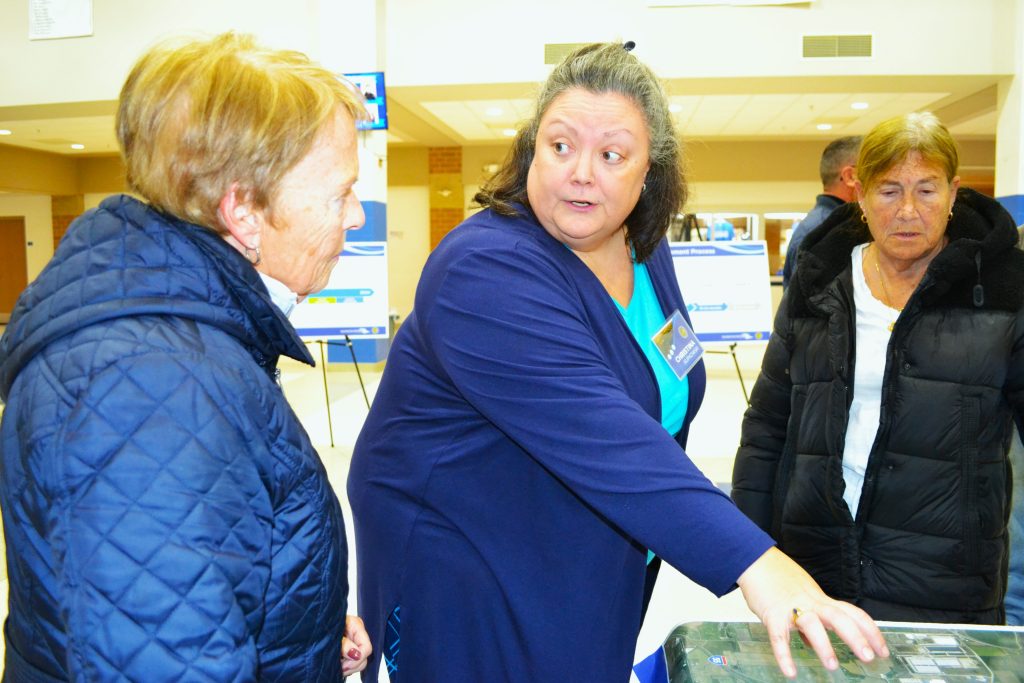Peotone Residents Get a Look at Wilmington-Peotone Road Study

Christina Kupkowski, center, answers questions about the PEL study on Wilmington-Peotone Road expansion at a December 13 open house in Peotone. (Photo by Karen Haave)
By Karen Haave
Planners for the Will County Department of Highways don’t know exactly what improvements will be needed for Wilmington-Peotone Road in the future, but they are pretty sure something will be.
To that end, they are seeking input from residents and those who frequently travel in the 22-mile corridor from Drecksler Avenue in Peotone to just east of Boathouse Road in Wilmington.
A December 13 public meeting at Peotone High School was geared to get that started. A similar open house was held December 6 in Wilmington.
Christina Kupkowski, Phase I Project Manager for the county highway department, said the purpose of the forum was threefold: to understand the existing and future travel demand; to provide efficient east-west mobility for all users throughout the corridor; and to develop a corridor that can handle travel demand in a safe manner to support the economic vitality of Will County.
Kupkowski noted that the Planning and Environmental Linkages (PEL) study is in its very early stages, and without “futures” that project traffic volume, options for improvements can’t be designed.
“Turn lanes and widening are likely options,” she said. “But right now, we just don’t know.”
The uncertainty over what those improvements might be was a cause for concern for many of the residents who attended the meeting.
Drainage and flooding were issues for some, while the possibility of the loss of property and home value were significant to others who live along the highway.
“If they widen it, they will need to acquire our front lawn,” said one woman, who asked that her name not be used.
She said she and her husband, a retired farmer, have lived along Wilmington-Peotone Road for 50 years and don’t want to have to sell their home and move.
And if the road is widened and front yards shortened, she said, “We would never be able to sell that house. There’s a lot of people in the same circumstances.”
Other residents at the meeting had similar concerns, one writing a Post It note and placing it on the displayed location map citing “drainage from the south side to the north side causing flooding and erosion.”
Another wrote that they were “worried about land values.”
Traffic volumes and patterns are at the top of the list for analysis, along with safety and crash data, drainage requirements, bridges and other structures, existing and planned utilities, multimodal access, cost, social and community impacts, stakeholder and public input, environmental constraints such as land use, water resources, and natural resources.
The analysis will be used to develop a purpose and need statement, which defines the transportation problem and outlines goals and objectives. This sets the stage for consideration of “reasonable options for improvements” with “justification for expenditure of public funds.”
Others who want to comment can do so by visiting the website www.wilmingtonpeotonestudy.com . Deadline for comments is Jan. 12, 2024.
In the meantime, the PEL study will evaluate alternatives, a process expected to take 12 to 18 months.
PHASE I, Preliminary Engineering & Environmental Studies, will follow and take another 18 to 24 months.
PHASE II is Contract Plan Preparation & Land Acquisition, also 18 to 24 months, with PHASE III Project Construction after that.
Completion of the study will clear the way for another round of public meetings in 2024.
Karen Haave is a freelance reporter.